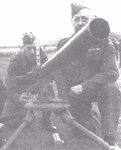Seawitch
Airman 1st Class
Hi All
In 1980 I was on a Shell Tanker, the 2nd Steward was a man who, with nearly 50 years at sea, had served on the wartime convoys, and had lots of tales to tell as well.
He showed me a qualification in his discharge book of that time Rocket Cable it said.
He explained how he would launch this small weapon from the ship, a Rocket would be fired up, towing a cable behind it, it's descent slowed by a small parachute.
The object was to tangle the propellers of enemy aircraft he said.
He never heard of any harm being done with it though.
Anyone else got one to add?
In 1980 I was on a Shell Tanker, the 2nd Steward was a man who, with nearly 50 years at sea, had served on the wartime convoys, and had lots of tales to tell as well.
He showed me a qualification in his discharge book of that time Rocket Cable it said.
He explained how he would launch this small weapon from the ship, a Rocket would be fired up, towing a cable behind it, it's descent slowed by a small parachute.
The object was to tangle the propellers of enemy aircraft he said.
He never heard of any harm being done with it though.
Anyone else got one to add?


